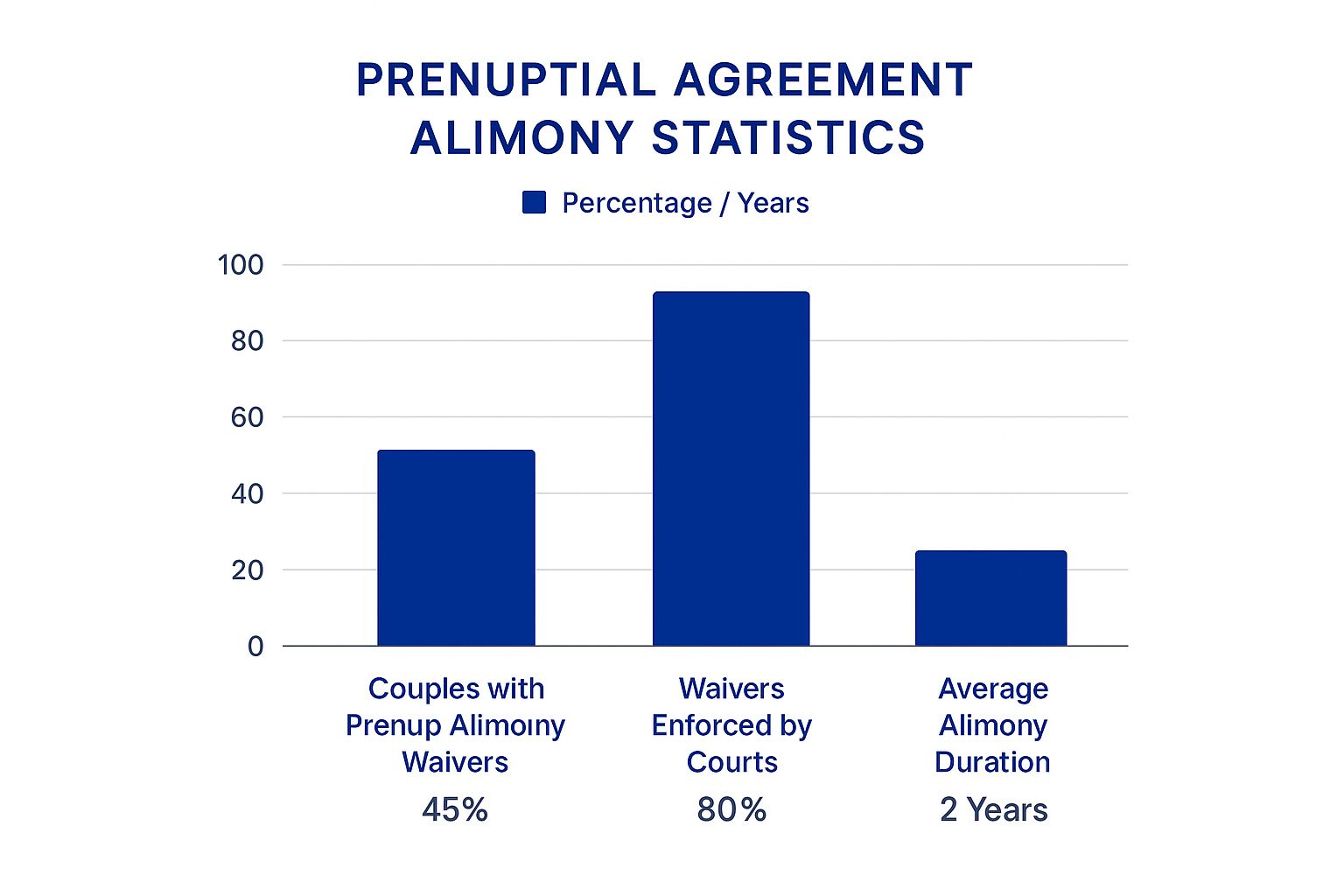Can A Prenup Prevent Alimony Under NY Divorce Laws

Extra, extra, read all about it. The clever old prenuptial agreement can potentially keep you from tripping, slipping and falling into legal traps that your nitty gritty spouse may set for you…or can it?
If you have not heard of a “Prenup” as they call it, then you probably don’t watch TV or you are disconnected from Hollywood. That’s because celebrities have made this legal document more popular than Sushi because well, let’s face it, there marriage stands little chance of succeeding. Alimony is the name of the game and today we want to know how the beloved prenup interacts with legal variable. Many individuals considering marriage often ask, “Does a prenup prevent alimony?” The answer isn’t a simple yes or no. A prenuptial agreement can address alimony, but its effectiveness depends on several factors.
It’s important to understand the difference between waiving, limiting, and modifying alimony. Waiving alimony aims to eliminate any future obligation. Limiting it sets a cap on the payment amount or duration. Modifying alimony adjusts standard state guidelines, tailoring them to the couple.
These distinctions are crucial if a prenup is challenged in court.
Understanding The Nuances of Alimony Provisions
A prenup can’t simply declare “no alimony” and be guaranteed enforceable. Enforceability varies by state and depends on the specific wording and circumstances of the agreement. For instance, a prenuptial agreement can impact the amount and duration of alimony payments.
One spouse might agree to less alimony for a shorter time than state law dictates. This offers some financial protection while acknowledging the possibility of spousal support.
Prenuptial agreements are increasingly recognized as a way to manage financial expectations within a marriage, especially concerning alimony. In New York, a prenup can limit or waive alimony if it meets legal requirements. This allows couples to agree on finances beforehand, potentially minimizing future disputes.
However, courts can override provisions causing undue hardship, potentially leading to public assistance. With increasingly complex finances in marriages, prenups are more popular for clarifying financial responsibilities and avoiding legal battles over alimony.
Protecting Your Interests While Maintaining Enforceability
When drafting a prenup, you need strategies to protect assets.
One common approach ties alimony to the marriage length. For example, a prenup might stipulate no alimony for marriages under five years, then increasing amounts for longer durations. This acknowledges the evolving financial interdependence over time.
Another strategy involves a lump-sum payment instead of ongoing alimony. This provides a clean break and financial certainty. These creative solutions are often more likely to be upheld in court than a blanket waiver. Such provisions offer predictability and can help avoid costly litigation.
State-by-State: Where Prenups Can Actually Block Alimony
The enforceability of waiving alimony in a prenuptial agreement varies greatly across the United States. This creates a complex legal landscape for couples considering this option. Understanding these state-specific nuances is especially important for those who own property in multiple states or plan to relocate.
Navigating the Patchwork of Alimony Laws
Some states, like Florida and Nevada, are generally permissive regarding prenuptial agreements that waive or limit alimony, as long as certain conditions are met. This offers significant protection for individuals looking to safeguard their assets. However, other states have stricter rules.
For instance, states like California tend to scrutinize alimony waivers more closely, especially if the waiver seems unfair to one spouse at the time of divorce. This can create a situation where a prenuptial agreement valid in one state could be challenged or even invalidated after moving to another.
The use of prenuptial agreements has risen, with increased adoption among couples in second (60%) or third (73%) marriages, often because of pre-existing assets and prior divorce experiences.
To help clarify the different approaches, the following table provides a state-by-state comparison:
State-by-State Approach to Alimony in Prenuptial Agreements
This table compares how different states treat alimony provisions in prenuptial agreements, highlighting which states allow complete elimination versus those with restrictions.
| State | Can Prenup Eliminate Alimony? | Notable Restrictions | Legal Standard |
|---|---|---|---|
| California | Yes, but subject to judicial review | Courts may invalidate waivers deemed unconscionable or unfair at the time of divorce | Case law based; influenced by public policy favoring spousal support |
| Florida | Generally yes | Must be fair and reasonable at the time of execution and enforcement | Uniform Premarital Agreement Act (UPAA); emphasis on contractual freedom |
| Nevada | Generally yes | Similar to Florida; requires fairness and reasonableness | UPAA; strong emphasis on upholding prenuptial agreements |
| New York | Yes | Subject to judicial review for fairness and unconscionability | Case law and statutory considerations |
| Texas | Yes | Must be fair and reasonable; waivers cannot leave a spouse destitute | UPAA; emphasis on protecting both spouses |
This table demonstrates the range of approaches to alimony waivers in prenuptial agreements. While some states favor upholding these waivers, others prioritize protecting spouses from unfair or unreasonable outcomes.
The Uniform Premarital Agreement Act (UPAA) and its Impact
Many states, currently 28, have adopted the Uniform Premarital Agreement Act (UPAA), providing a framework for creating and enforcing prenuptial agreements. However, even within these states, judicial interpretations can differ.
This means that even with the UPAA, variations exist in how alimony waivers are treated. Consulting with an attorney in your jurisdiction is essential to ensure your prenuptial agreement complies with local laws.
Visualizing State-by-State Trends
The infographic below visualizes data comparing the percentage of couples using prenuptial alimony waivers, how often those waivers are enforced, and the average alimony duration with a prenup.

The infographic shows that despite many couples choosing alimony waivers, the enforcement rate and effect on alimony duration vary significantly. This highlights the importance of understanding your state’s specific laws when considering an alimony waiver in a prenuptial agreement. Careful planning and legal advice are vital to navigate these complexities and ensure your agreement offers the protection you seek.
Building an Ironclad Alimony Provision That Holds Up

A prenuptial agreement can address alimony, but its enforceability depends on careful drafting. What distinguishes a robust alimony provision from one easily overturned? The answer lies in understanding the crucial elements that give these clauses strength.
Essential Elements for Enforceability
Several factors contribute to a strong alimony provision. Full financial disclosure from both parties is essential. Hiding assets or misrepresenting finances can invalidate the entire agreement. It’s like building a house on a weak foundation – it simply won’t last.
Voluntary consent is also vital. A prenuptial agreement signed under duress or pressure is unlikely to hold up in court. Both parties must have sufficient time to review the agreement with their own independent legal counsel. This ensures everyone understands the implications and agrees to the terms willingly.
Finally, proper legal representation is crucial. An experienced family law attorney specializing in prenuptial agreements can navigate the complexities of state-specific laws and ensure the document is legally sound.
Avoiding Costly Mistakes
Seemingly small procedural oversights can lead to invalidated agreements, resulting in unforeseen alimony payments. A rushed signing process without adequate time for review can raise concerns in court. Likewise, insufficient legal representation can create loopholes that a judge might exploit.
Consider a case where a couple signed a prenuptial agreement mere days before their wedding. The wife, without independent counsel, later successfully argued she hadn’t had enough time to review the intricate financial details, making the alimony waiver unenforceable. Cases like this highlight the need for thorough planning and execution. Statistics show that roughly 24% of premarital contracts address alimony modifications, indicating a move toward proactive financial planning. Find more detailed statistics here. The Uniform Premarital Agreement Act (UPAA), adopted by many states, provides a legal framework for these agreements.
Ensuring Your Provisions Stand Up to Scrutiny
By following these principles, couples can create an alimony provision that can withstand legal challenges. This involves:
- Detailed Documentation: Maintain thorough records of all financial disclosures, communications, and legal consultations related to the prenuptial agreement.
- Independent Counsel: Each party should retain their own attorney to guarantee independent advice and representation.
- Sufficient Time: Allow ample time for review and negotiation, avoiding any last-minute pressures.
These steps, while sometimes disregarded, significantly contribute to the enforceability of the prenuptial agreement and its alimony provisions. Creating a robust, legally sound prenuptial agreement demands proactive planning, complete transparency, and expert legal guidance.
When Courts Override Prenup Alimony Provisions
While a prenuptial agreement can address alimony, the question “does a prenup prevent alimony?” isn’t always straightforward. Even the most carefully drafted agreements can be challenged. Surprisingly, courts sometimes override pre-agreed alimony waivers, potentially leaving one spouse entitled to support despite the prenup.
Understanding “Unconscionability”
One reason a court might disregard an alimony waiver is unconscionability. This legal term describes a contract provision so unfair or one-sided that it’s deemed unacceptable. For example, if enforcing the waiver would leave a spouse destitute and reliant on public assistance, a judge might consider it unconscionable. The court could then refuse to enforce it. This often arises when there’s a significant difference in the couple’s financial resources.
The Impact of Changed Circumstances
Life is full of unexpected turns. Situations unforeseen when the prenup was signed can greatly affect its enforceability. Dramatically changed circumstances, such as a severe illness or disability impacting one spouse’s earning ability, can lead a court to override the agreement.
A spouse who gave up their career to raise children might also be awarded alimony, even with a prior waiver. This is especially true in long-term marriages where one spouse’s earning potential was significantly reduced due to family responsibilities.
Public Policy Exceptions
Courts also consider public policy when reviewing prenups. A fundamental principle is preventing individuals from becoming a burden on the state. If enforcing an alimony waiver would force someone onto government assistance, a court is likely to intervene. They may then order some form of spousal support. This highlights a limitation of prenups as absolute safeguards against alimony.
Child-Rearing Responsibilities and Alimony
Child-rearing is another key consideration. Even with a prenuptial agreement waiving alimony, courts may award support to the primary caregiver to protect the children’s well-being. This is particularly relevant in long-term marriages where one spouse chose to focus on family, potentially impacting their earning power. These public policy factors demonstrate that while prenups are important, they don’t completely eliminate alimony obligations. Understanding these potential issues is essential for anyone considering a prenuptial agreement.
Smarter Alternatives to Full Alimony Waivers

While some couples opt to completely waive alimony in their prenuptial agreement, this can be a risky strategy. A complete waiver might be deemed unenforceable by a court, particularly if it creates undue hardship for one spouse. Fortunately, there are smarter alternatives. These options offer a degree of financial protection while improving the chances of court approval. Instead of eliminating alimony altogether, they focus on modifying it.
This demonstrates a willingness to provide support while still safeguarding individual assets.
Scaling Alimony Based on Marriage Duration
One effective strategy is to link alimony payments to the length of the marriage. This approach recognizes that financial interdependence usually deepens over time.
For example, a prenuptial agreement could stipulate no alimony for marriages shorter than five years, with gradually increasing payments for longer durations. A 10-year marriage might trigger a predetermined amount of support for a specific period. This provides a clear, predictable framework. It also acknowledges the evolving financial realities of long-term relationships.
Courts often view this strategy as more reasonable than a complete waiver, especially in longer marriages.
Lump-Sum Settlements and Property Transfers
Another alternative is a lump-sum payment instead of ongoing alimony. This offers a clean break and financial certainty for both parties. The lump-sum amount can be negotiated and clearly defined in the prenuptial agreement.
Similarly, transferring specific property can satisfy support obligations without the need for extended payment schedules. This could include assets like a vacation home or an investment account. These one-time transfers can be especially helpful for business owners seeking to shield their company from potential division in a divorce.
This method prevents ongoing entanglement and allows both spouses to move forward independently.
Incorporating Sunset Clauses and Trust Arrangements
Sunset clauses offer additional flexibility by ending alimony obligations after a certain timeframe. This provides temporary support during a transition period, after which the obligation ceases. For instance, alimony could be paid for a set number of years following a long-term marriage. This gives the receiving spouse time to become self-sufficient.
Another sophisticated option involves creating a trust. A trust can be funded with assets earmarked for spousal support, ensuring a reliable income stream. Importantly, it avoids directly linking the support to one spouse’s ongoing earnings. This method can be especially beneficial when dealing with substantial assets.
These creative strategies often resonate well with courts, particularly when they address specific needs and promote financial stability.
To help illustrate the various alimony provision options and their nuances, let’s look at the following table:
Alimony Provision Options in Prenuptial Agreements
This table outlines different approaches to handling alimony in prenuptial agreements, from complete waivers to more flexible alternatives, with their respective advantages and limitations
| Provision Type | Description | Advantages | Potential Limitations | Court Acceptance |
|---|---|---|---|---|
| Complete Waiver | Both parties agree to forgo any alimony payments. | Provides maximum financial protection for the paying spouse. | Often challenged and may be unenforceable, especially if it creates significant hardship. | Low |
| Duration-Based Alimony | Alimony amount or duration is tied to the length of the marriage. | More equitable than a complete waiver; acknowledges increasing financial interdependence over time. | Requires careful calculation and consideration of various scenarios. | Moderate to High |
| Lump-Sum Payment | A one-time payment is made in lieu of ongoing alimony. | Offers a clean break and financial certainty for both parties. | May not adequately address long-term needs, especially if circumstances change. | Moderate |
| Property Transfer | Specific property is transferred instead of alimony payments. | Can satisfy support obligations while avoiding ongoing payments. | Valuation of property can be complex; may not be suitable for all situations. | Moderate |
| Sunset Clause | Alimony payments terminate after a predetermined period. | Provides temporary support during a transitional phase. | May not provide sufficient long-term security for the receiving spouse. | Moderate to High |
| Trust Arrangement | A trust is established to fund spousal support. | Ensures a secure source of income without impacting the paying spouse’s ongoing earnings. | Can be complex to set up and administer. | High |
As you can see, several alternatives to complete alimony waivers exist, each with its own set of advantages and disadvantages.
These alternatives present more balanced approaches to alimony within a prenuptial agreement. They weigh individual financial security against potential future needs, increasing the likelihood of court approval. Consulting with an experienced family law attorney is crucial to tailor the right strategy for your unique situation. This ensures your prenuptial agreement offers the protection you desire while adhering to legal standards.
Crafting a Prenup That Protects Without Backfiring
The process of creating a solid prenuptial agreement is just as important as what goes into it, especially when it comes to alimony. This guide will walk you through every step, from those first conversations with your partner to the final signatures, offering insights into creating a prenup that effectively addresses alimony.
Initiating the Conversation
Talking about a prenup, particularly concerning alimony, can be uncomfortable. Approach the conversation with sensitivity and honesty. Frame it as a proactive way to address financial matters, not as a sign of doubt about the relationship. Focus on mutual protection and setting clear expectations, rather than presenting it as solely for protecting your individual assets.
Collaborative Negotiation
Negotiating a prenup should be a collaborative effort, not a battle. It’s not about “winning” but about finding a solution that works for both of you. The goal is to begin the marriage with a shared understanding of financial responsibilities, including potential alimony obligations. Starting a marriage with resentment over the prenup can create a negative foundation for the relationship.
Seeking Expert Legal Counsel
Choosing the right attorney is critical. Both partners should have their own independent legal counsel specializing in prenuptial agreements and familiar with state-specific alimony laws. A seasoned attorney can guide you through the complexities, ensuring the document is legally sound and meets your specific needs. Don’t cut corners here; sound legal advice can save significant stress and expense down the line.
Establishing a Realistic Timeline
A last-minute prenup can raise red flags for courts. Allow plenty of time for drafting, review, and negotiation. Rushing the process can create an impression of coercion or a lack of informed consent, increasing the risk of the agreement being challenged later. Adequate time allows both partners to fully grasp the implications and seek independent advice.
Ensuring Fairness and Transparency
Transparency is key. Full financial disclosure from both sides is essential for a valid prenup. Hiding assets or misrepresenting finances can invalidate the entire agreement. Meticulously document everything, keeping records of financial statements, communications, and legal consultations. Think of this as building a strong case for enforceability from the start. This transparency fosters trust and strengthens the agreement’s validity.
Addressing Alimony Directly
Can a prenup prevent alimony? It can, but a complete waiver can be risky. Alternatives like scaling alimony based on the length of the marriage or using lump-sum settlements are often more acceptable to courts. These approaches balance financial protection with acknowledging potential future needs and can also reduce the chance of the prenup being challenged.
Sample Alimony Provision Language
A common approach is to link alimony to the duration of the marriage. For example: “If the marriage ends after X years, Spouse A shall pay Spouse B alimony of $Y per month for Z years.” Consult your attorney to draft language specific to your situation. Clear, specific language helps avoid ambiguity and potential disputes.
Finalizing the Agreement
Once the agreement is complete, ensure both parties sign it willingly and with a full understanding of its contents. Each party should review the final version with their respective attorneys. This demonstrates informed consent, a critical factor in upholding its enforceability and helps prevent future claims of duress or misunderstanding.
By carefully addressing each step in this process, you improve the chances of creating a prenuptial agreement that protects your interests and can withstand potential legal challenges. A well-drafted, fair, and legally sound prenuptial agreement is a vital step in safeguarding your financial future.
Considering a prenuptial agreement in New York? Contact Aronov Law NY today for a free consultation with experienced divorce and family law attorneys.
98-14 Queens Blvd


